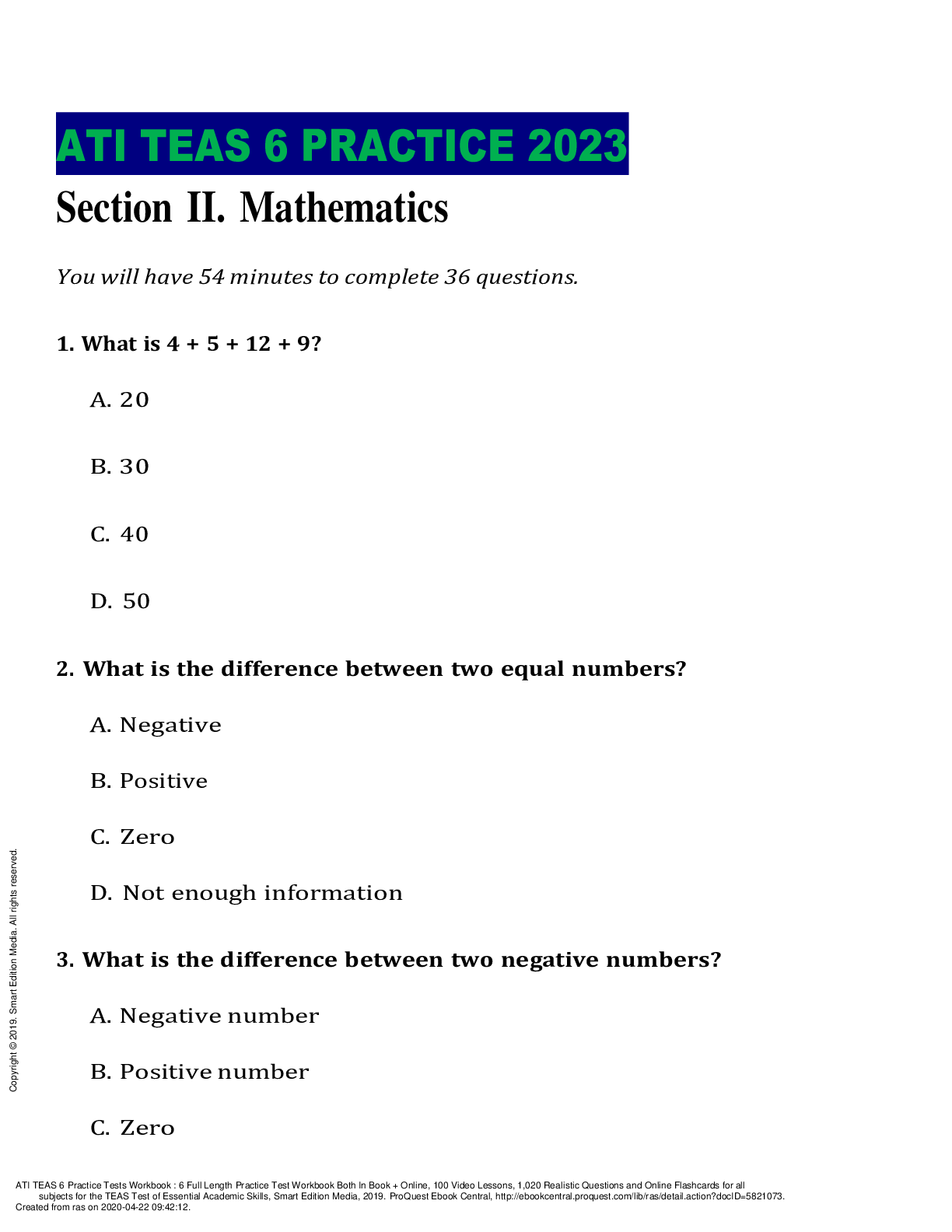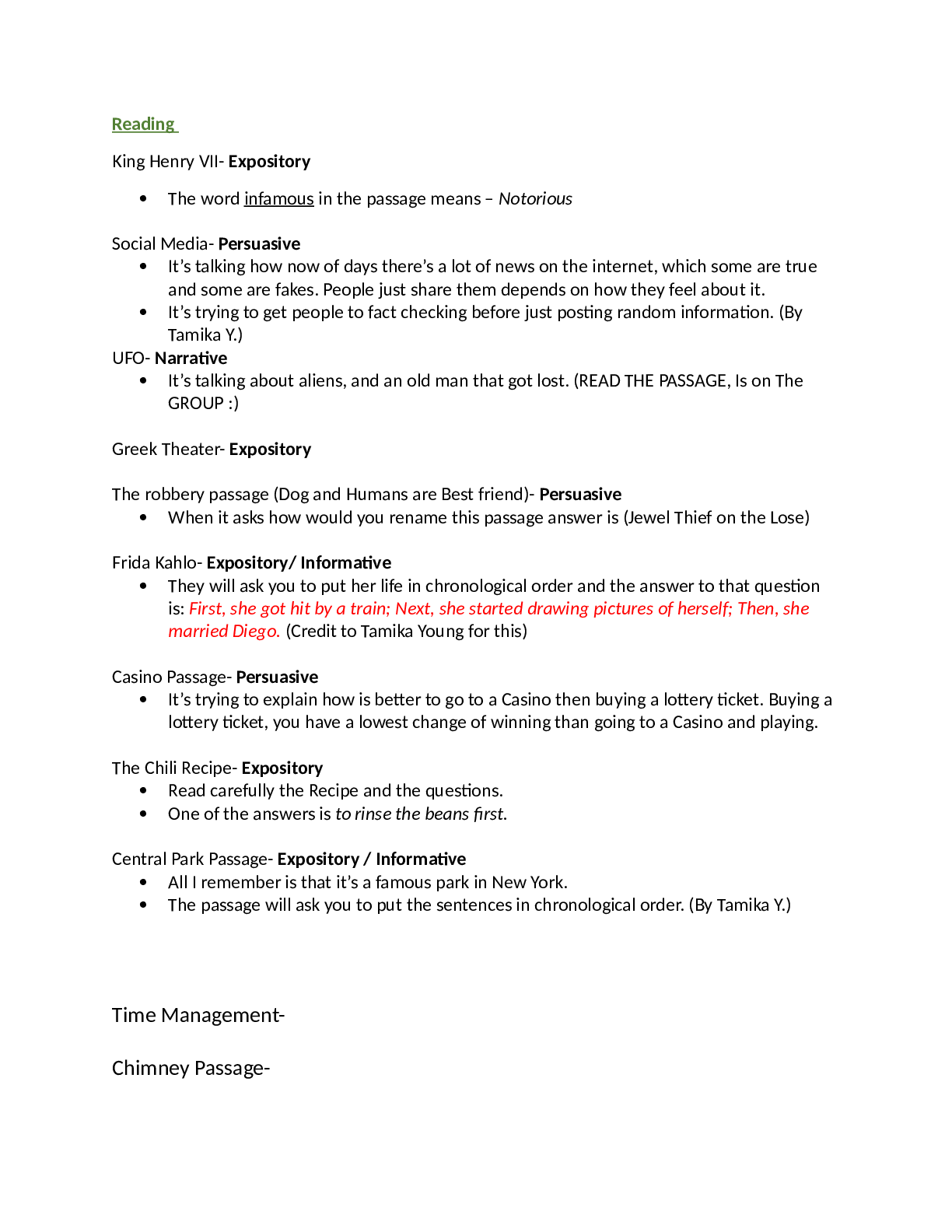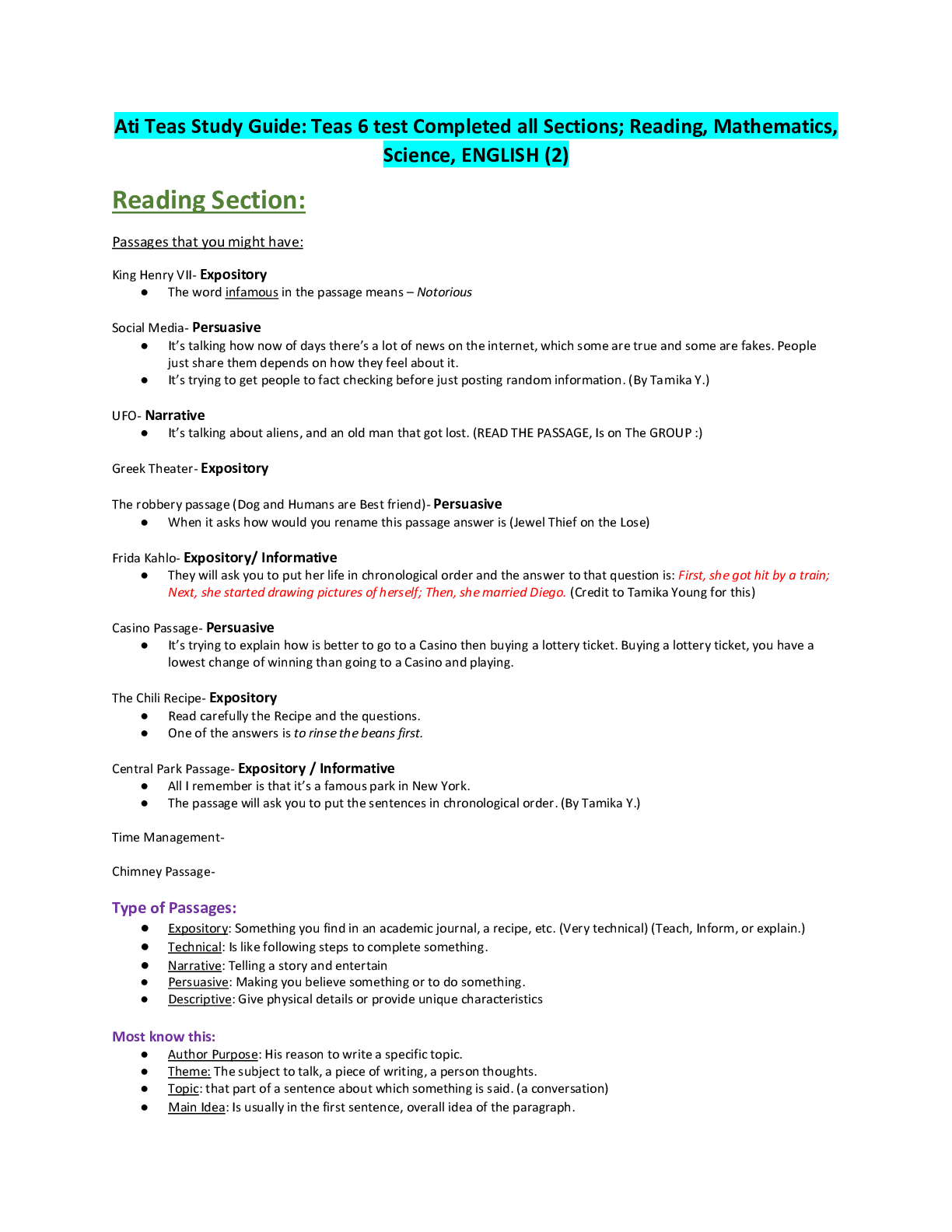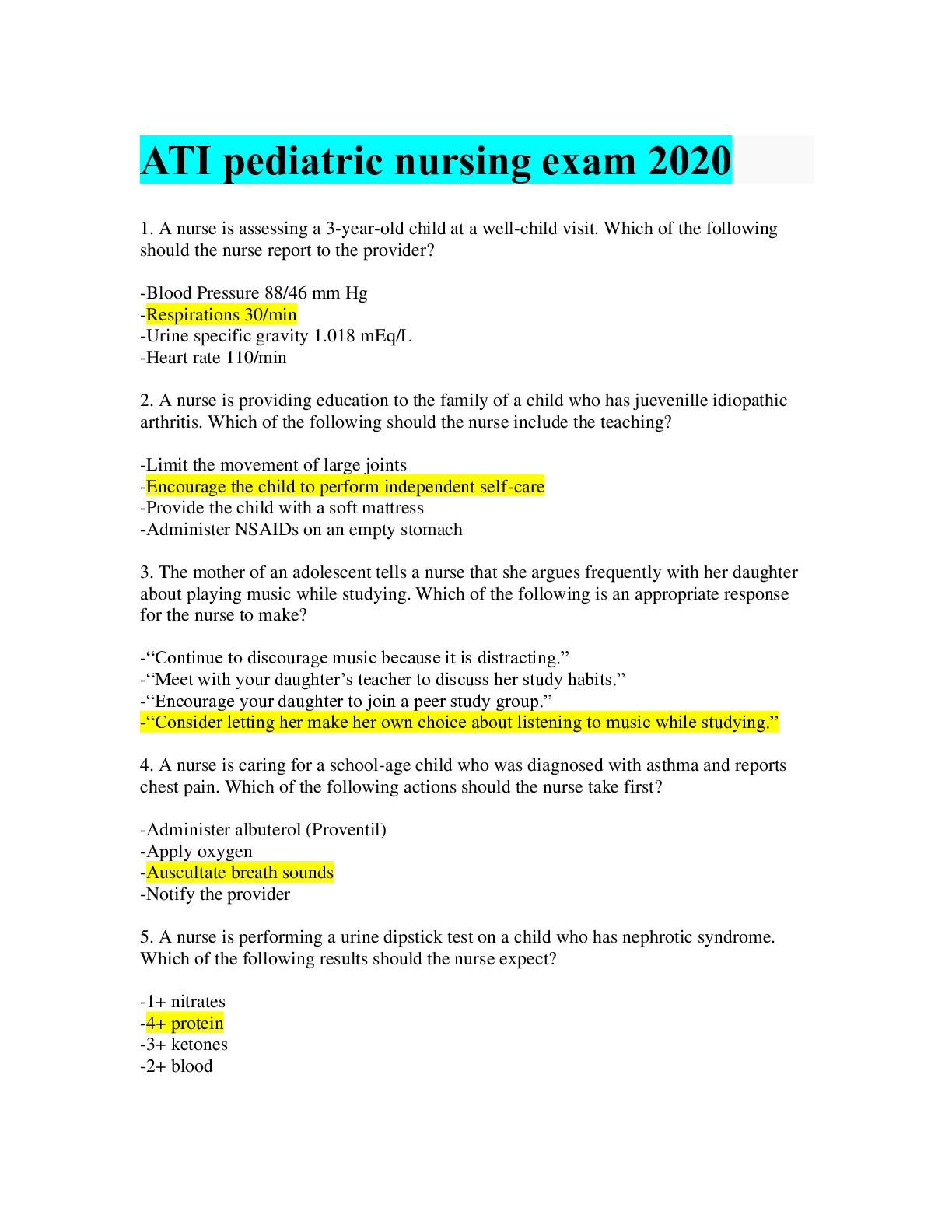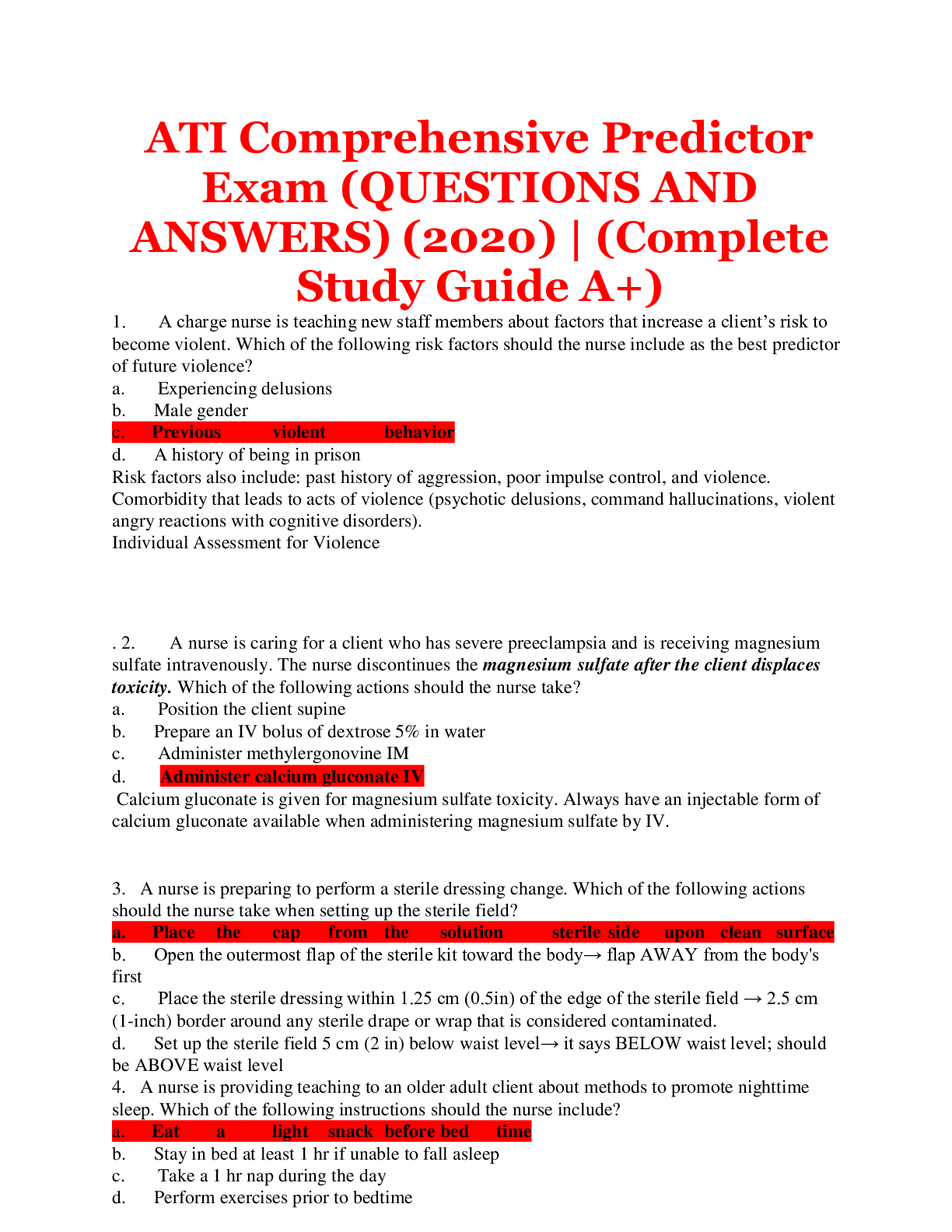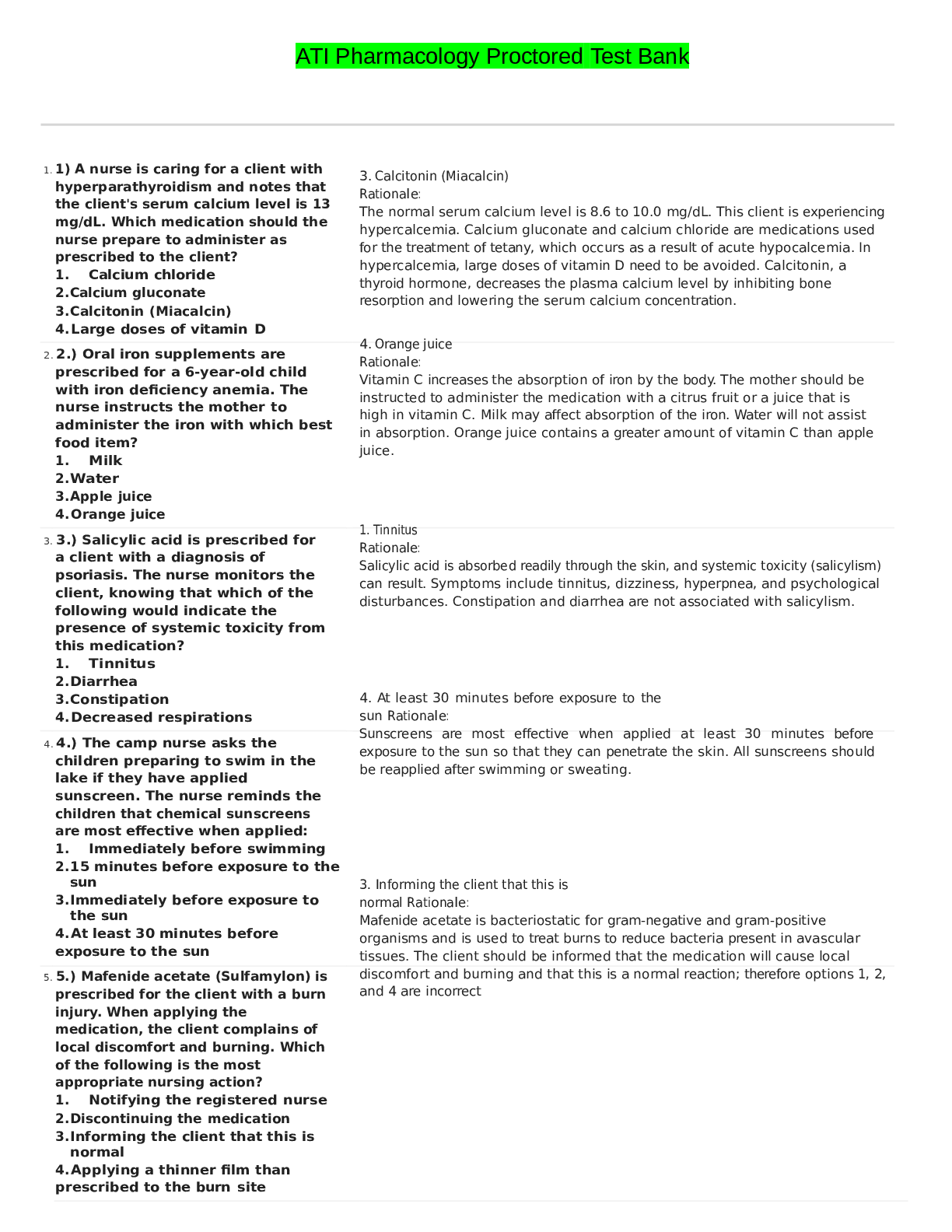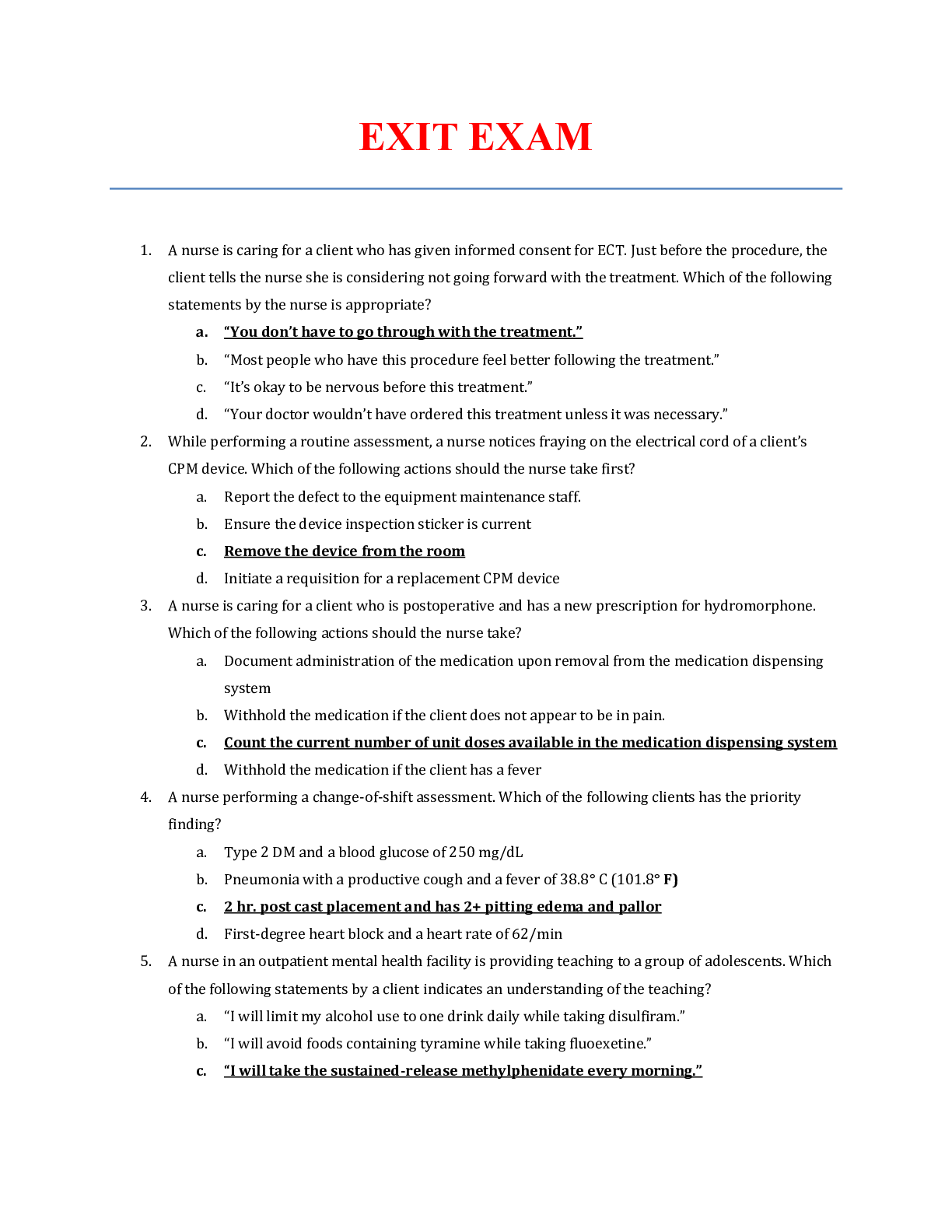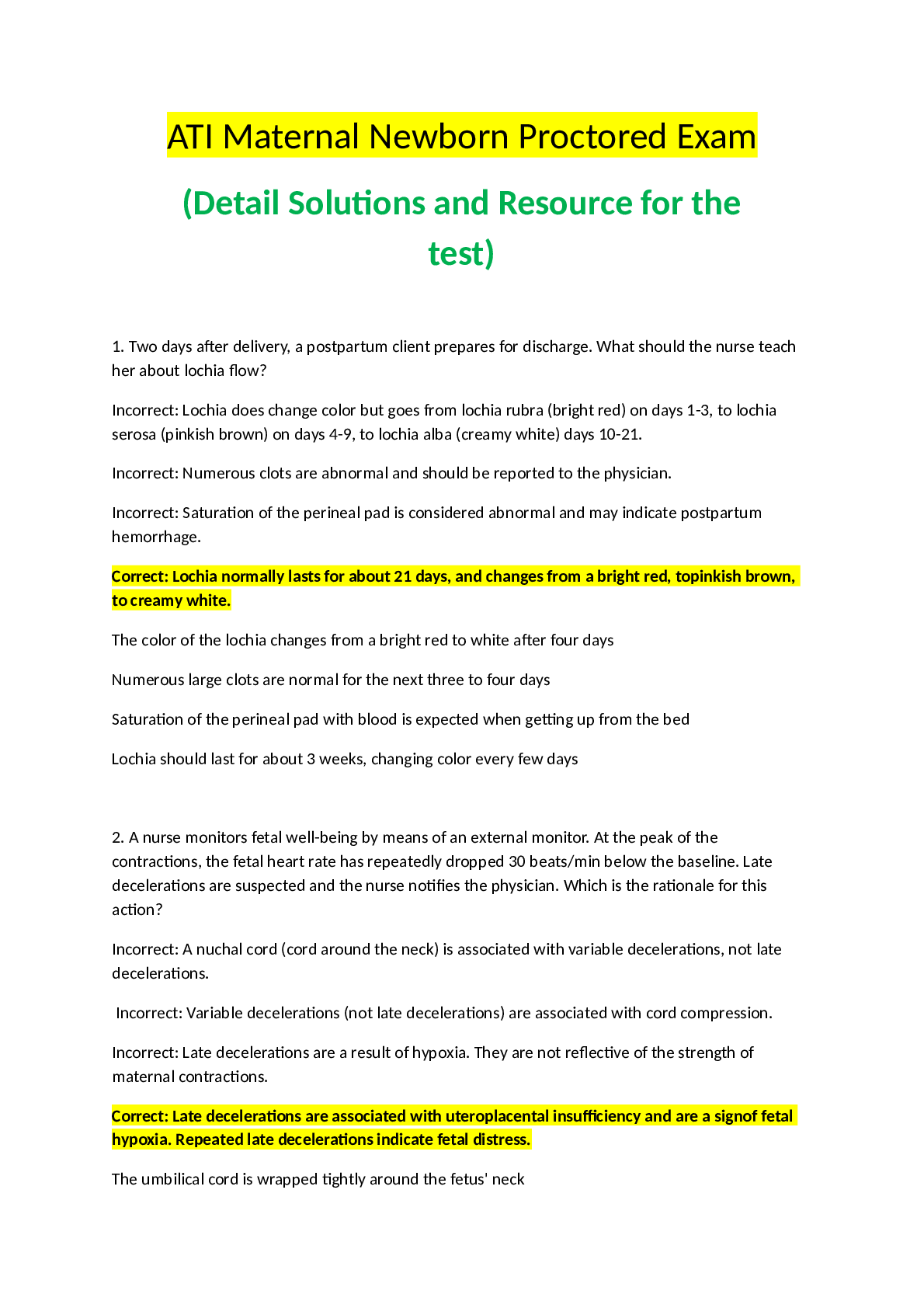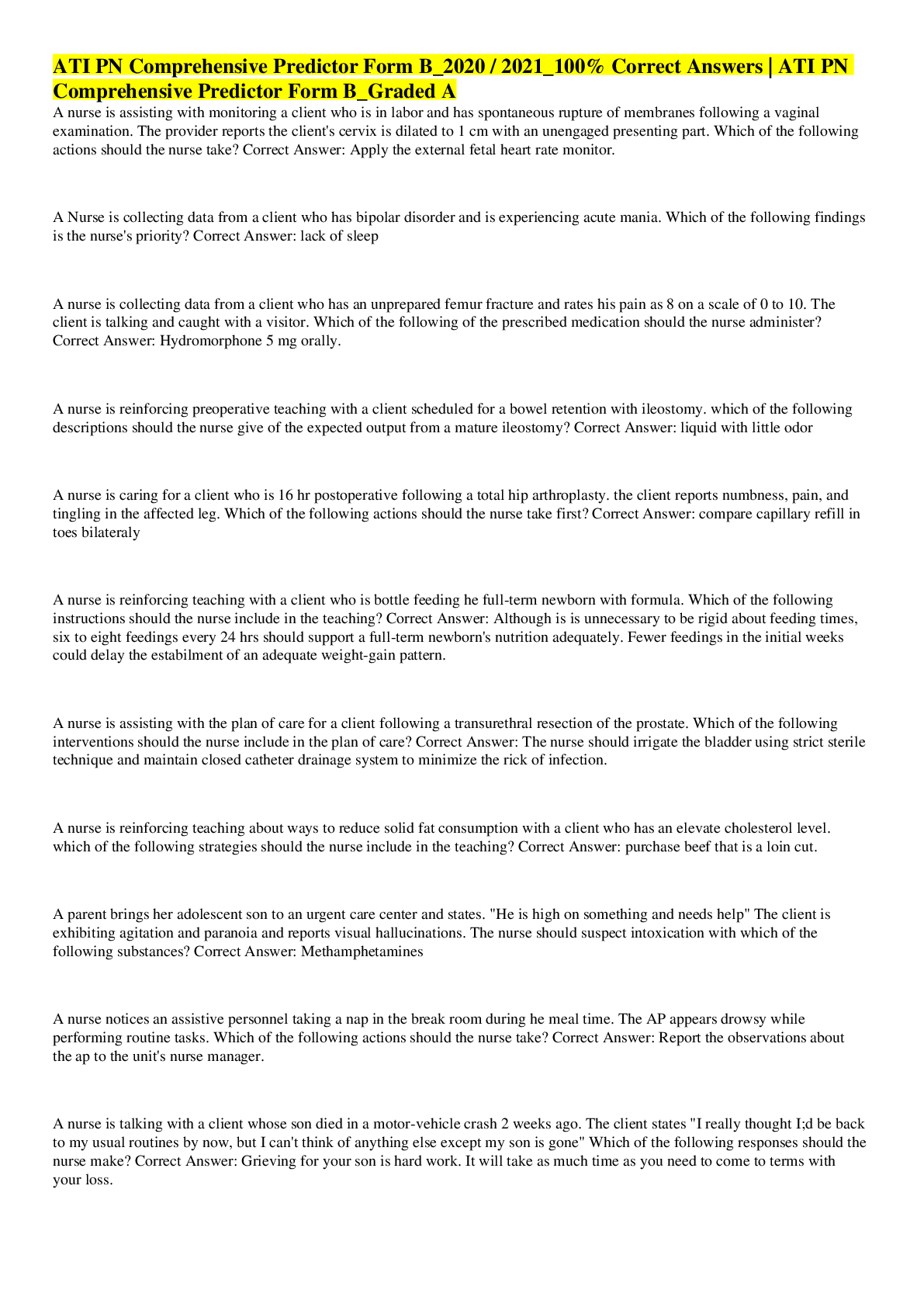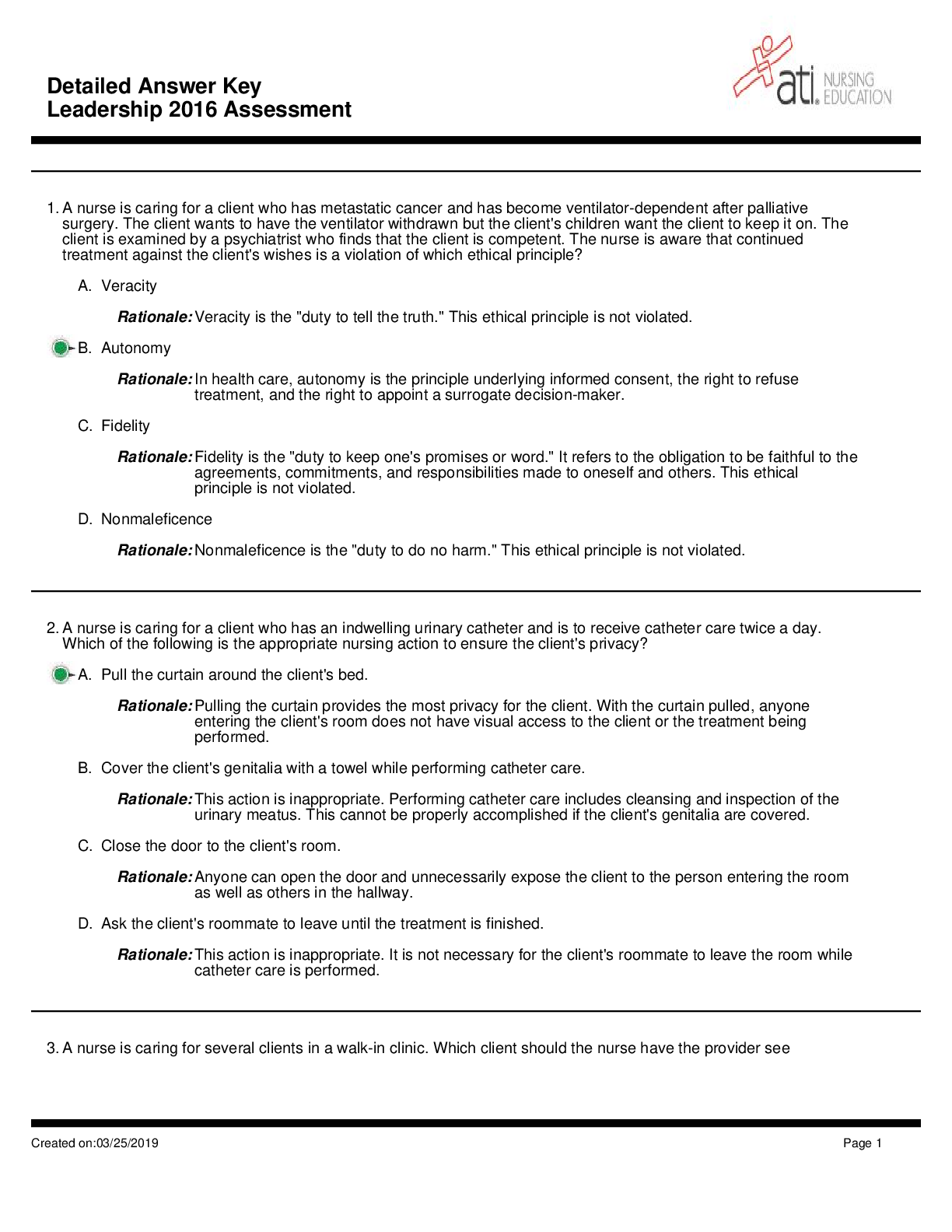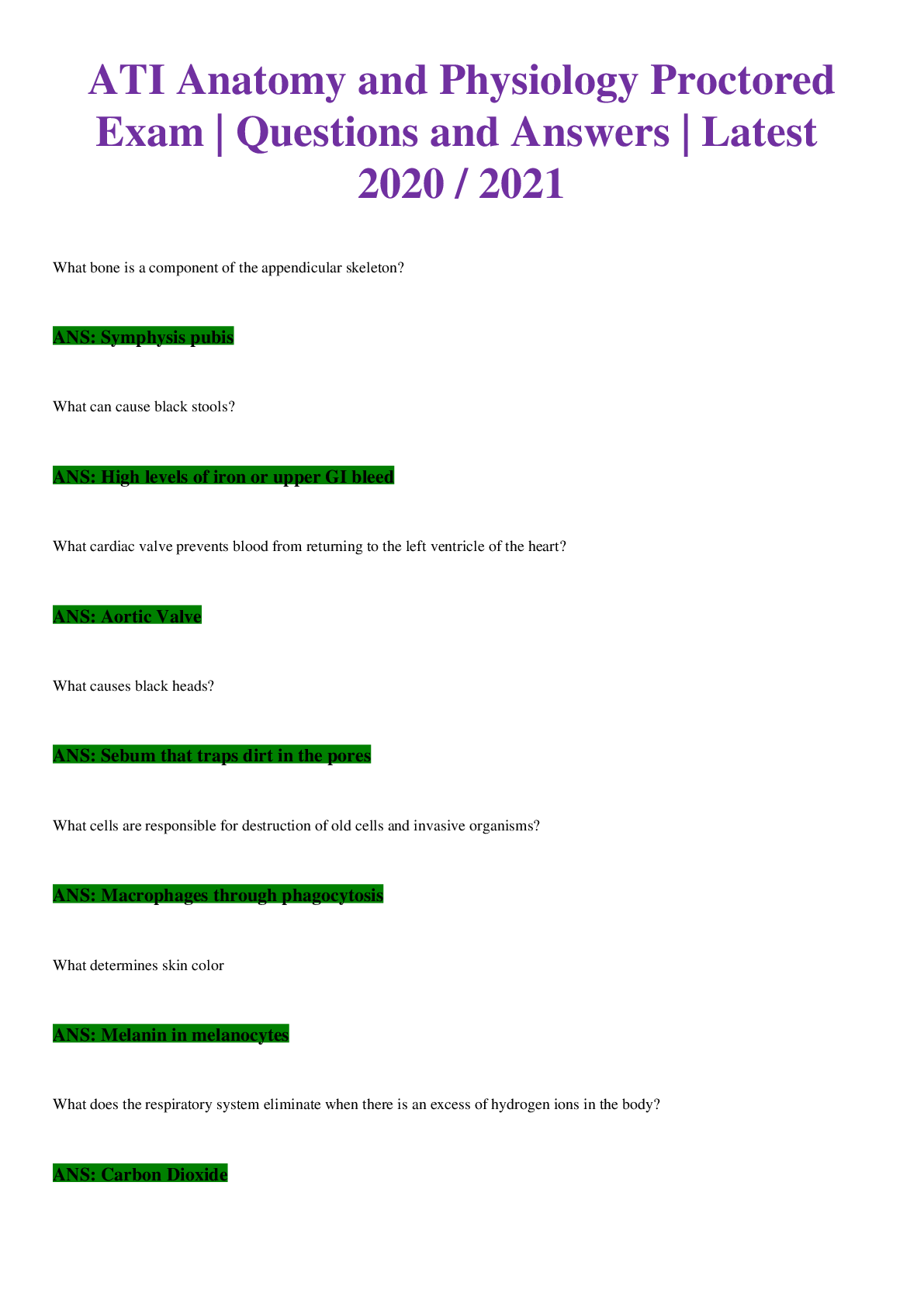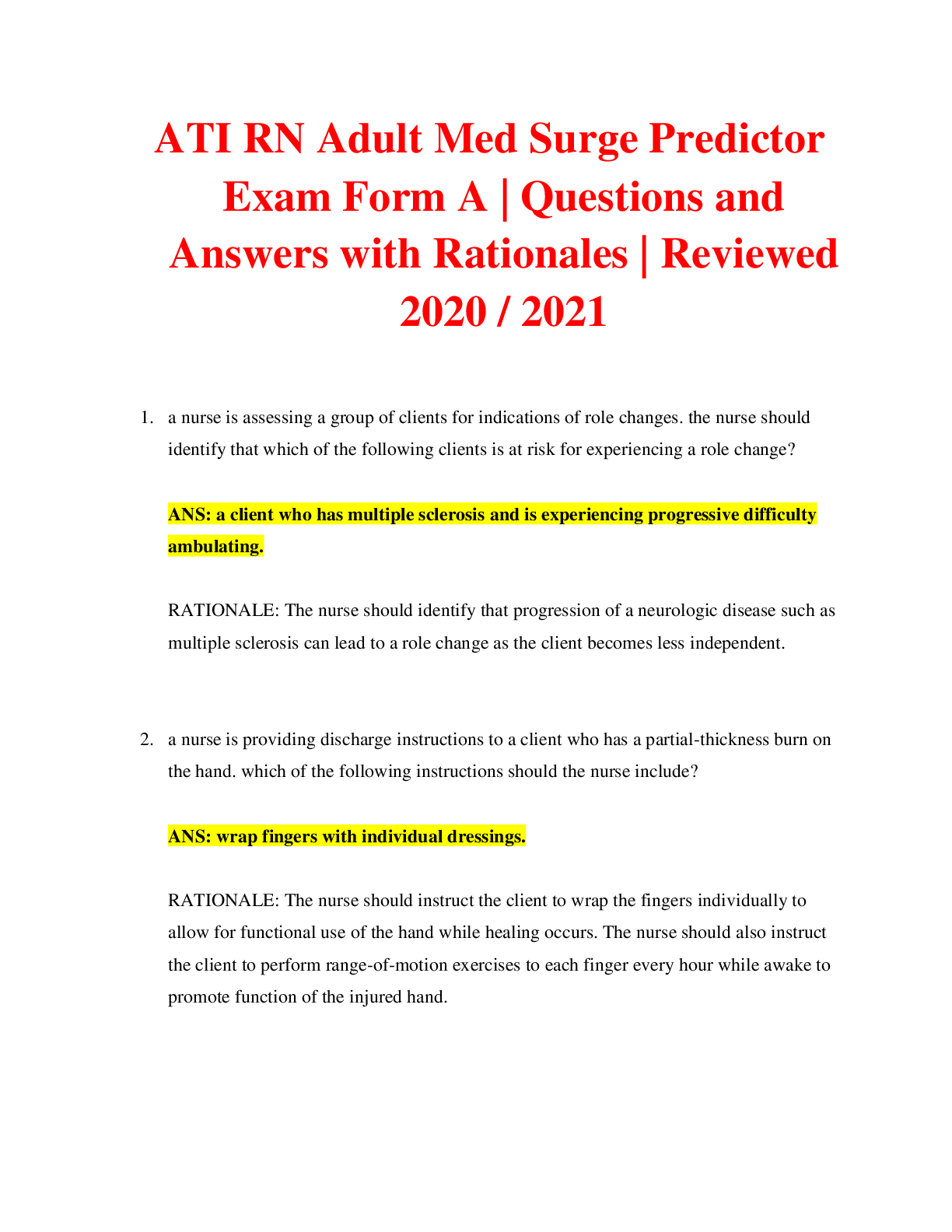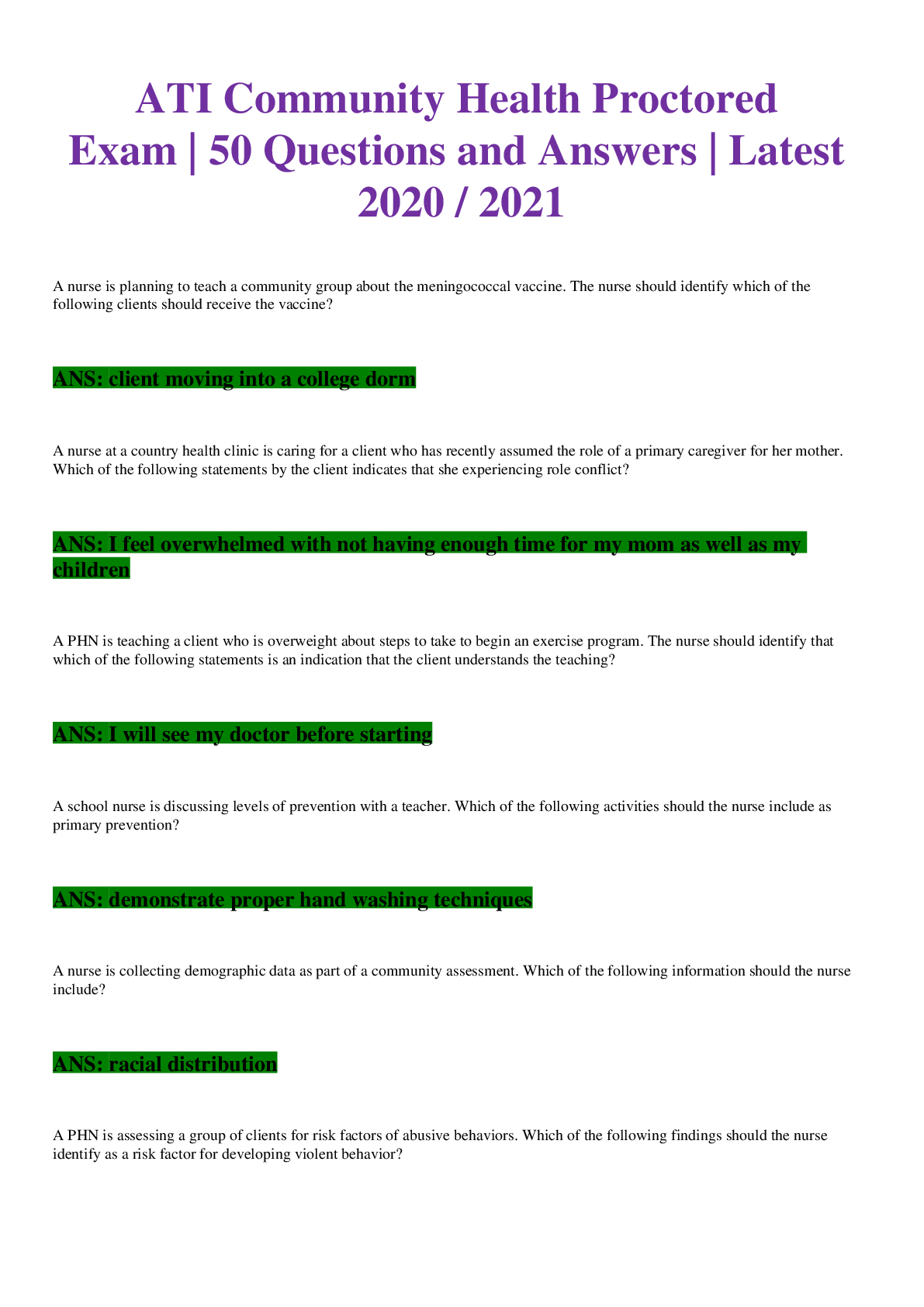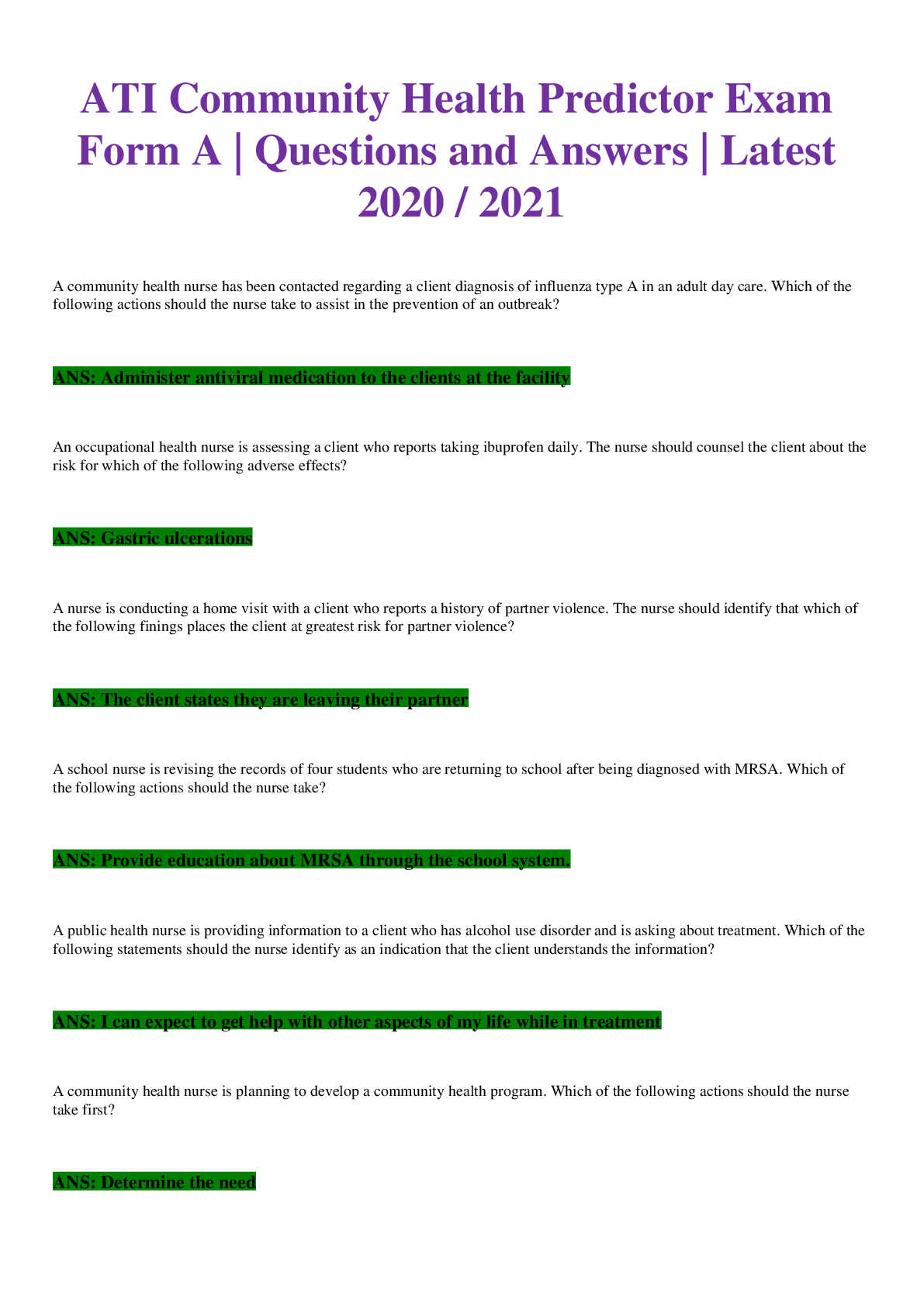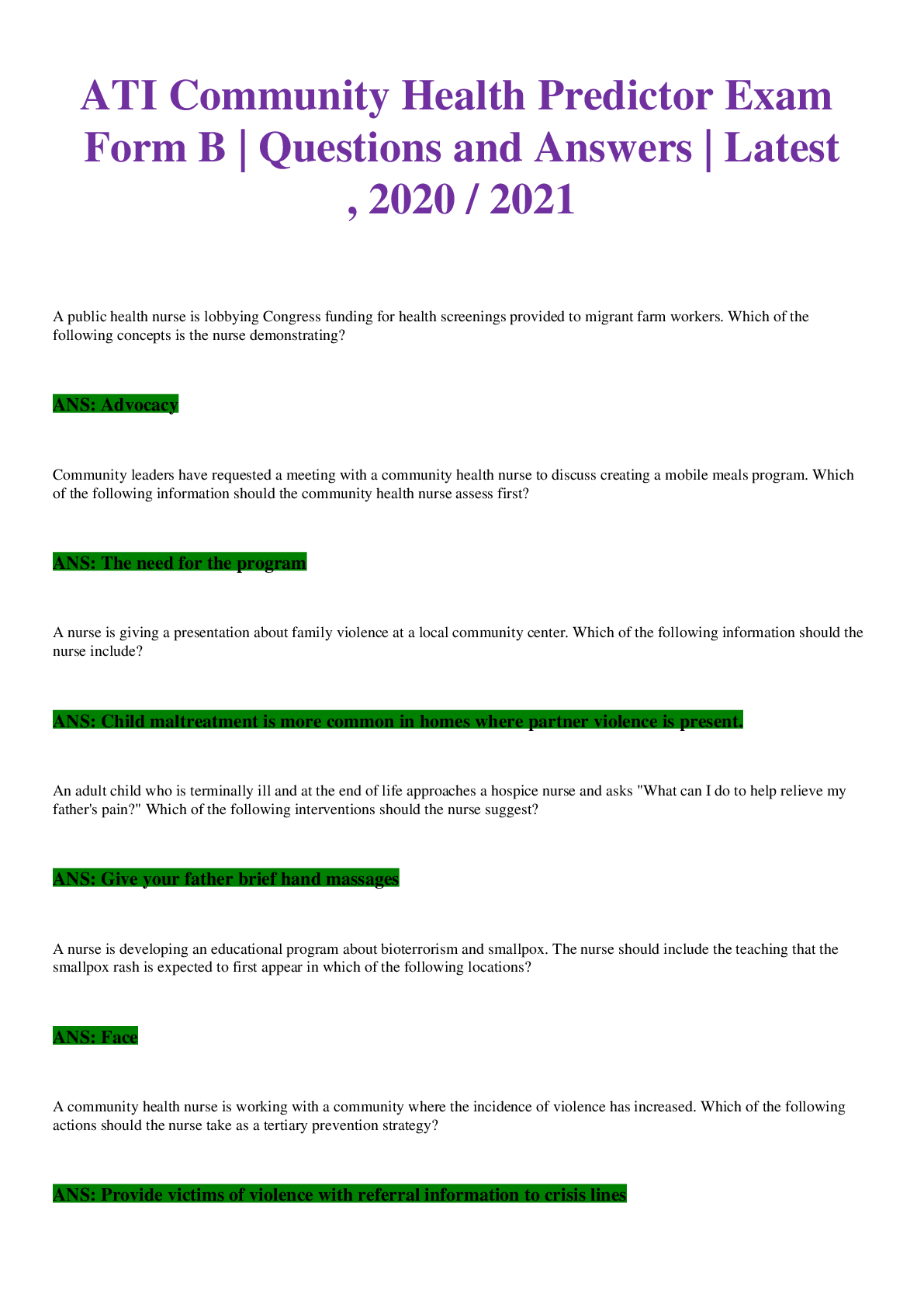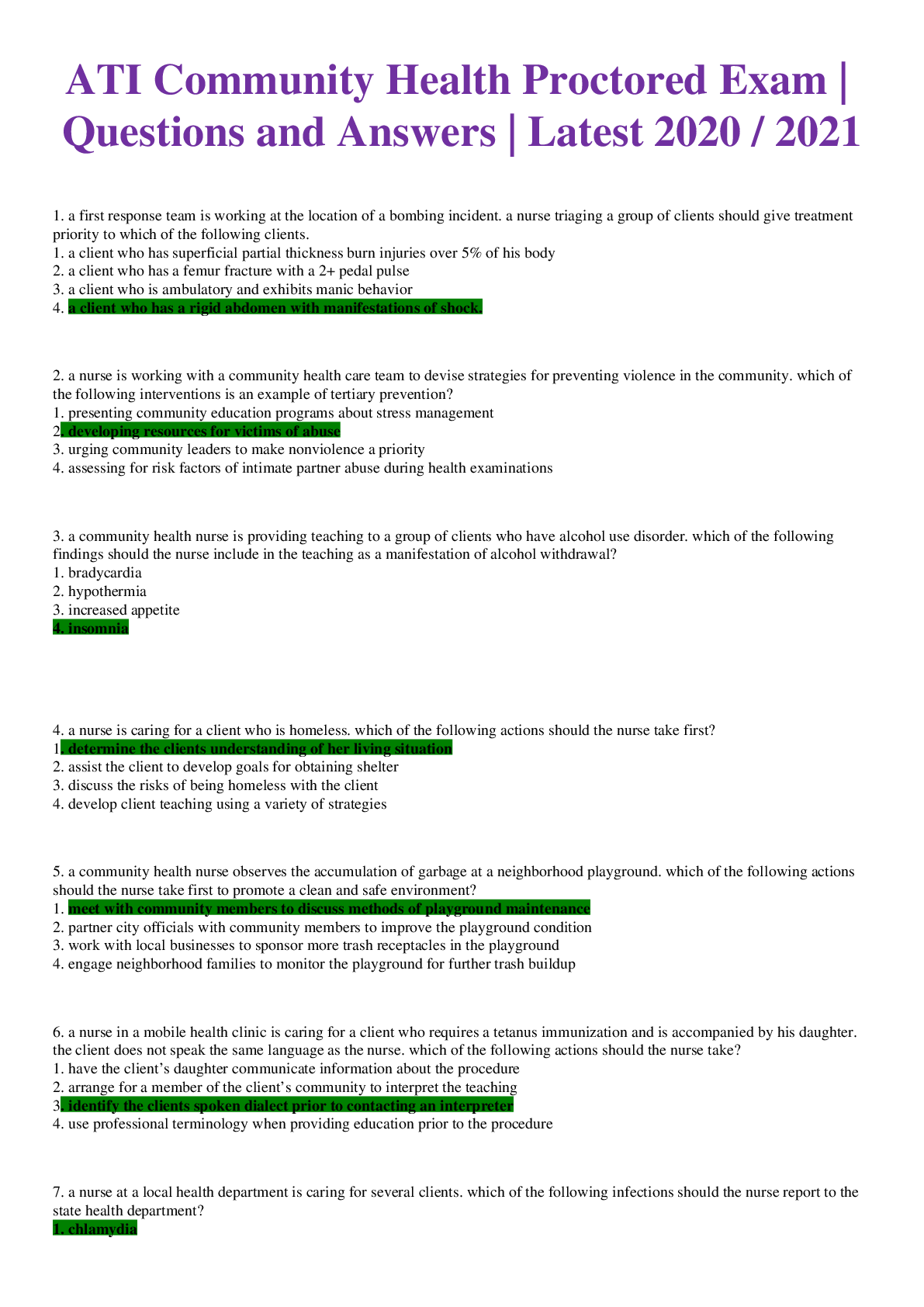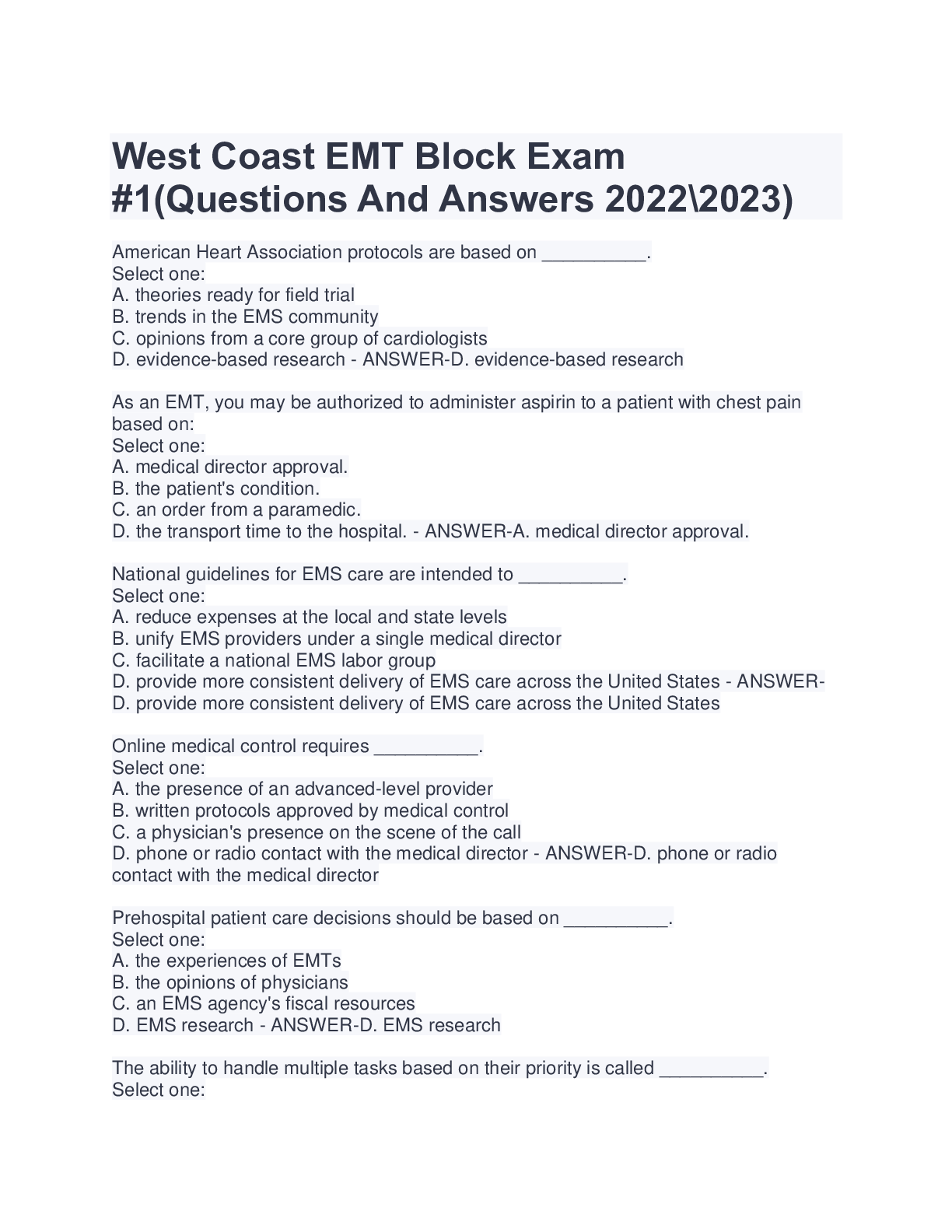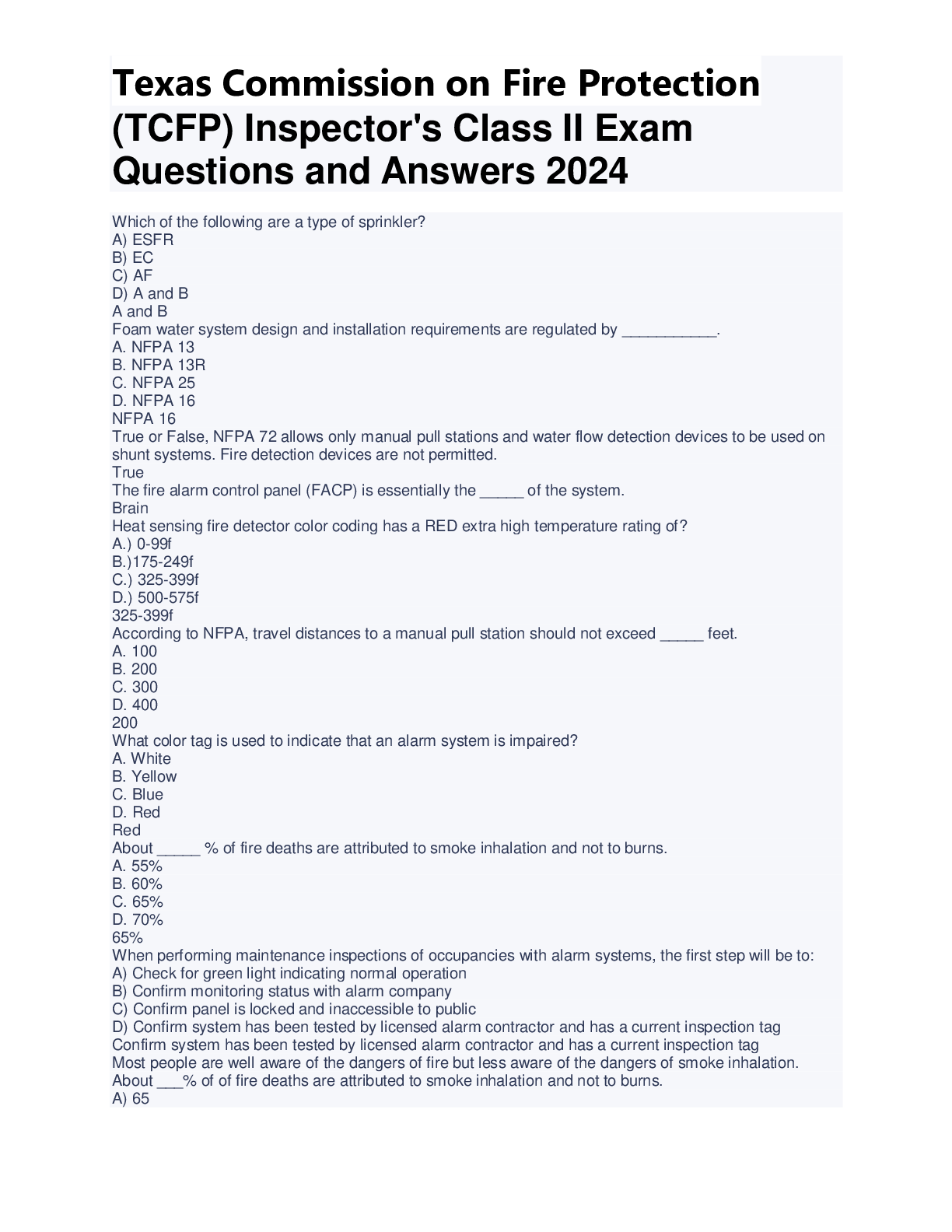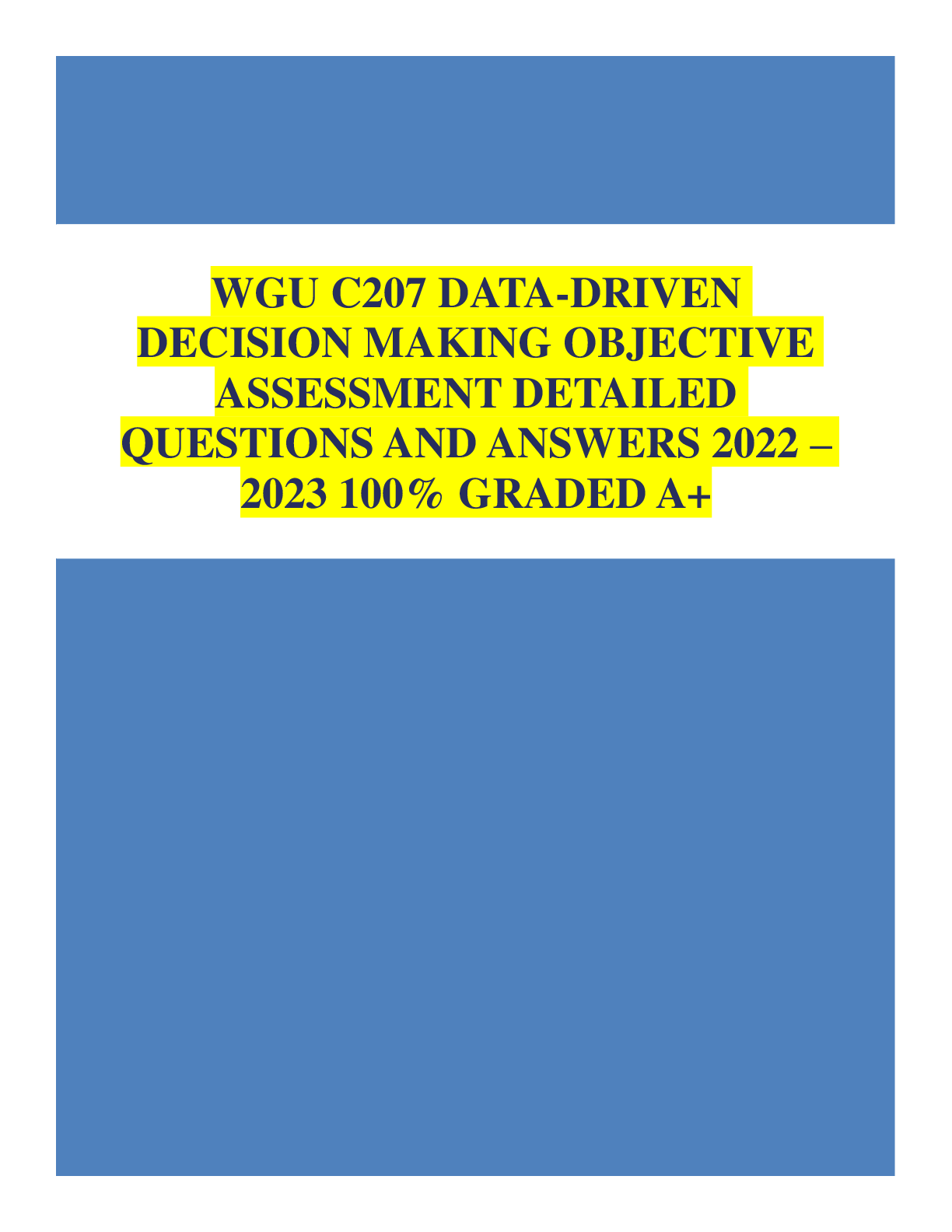*NURSING > QUESTIONS and ANSWERS > NURS 320 Periop MS Questions and Answers (ATI) / Periop MS Questions and Answers (ATI) Complete ques (All)
NURS 320 Periop MS Questions and Answers (ATI) / Periop MS Questions and Answers (ATI) Complete questions & answers (spring 2021)
Document Content and Description Below
Periop MS Questions and Answers (ATI) A client had an open transverse colectomy 5 days ago. The nurse enters the client’s room and recognizes that the wound has eviscerated. After covering the woun... d with a sterile, saline-soaked dressing, which of the following actions should the nurse take? Go to the nurses’ station to seek assistance. Reinsert the organs into the abdominal cavity. Place the client in reverse Trendelenburg position. Obtain vital signs to assess for shock. A nurse is caring for a client who is postoperative and has a Jackson-Pratt drain in place. Which of the following interventions should the nurse use to ensure proper functioning of the drain? Secure the drain to the client’s bed sheet. Clamp the drain when the client is ambulating. Empty and compress the drain reservoir as needed. – produces necessary suction Keep the drain higher than the surgical incision. A nurse is completing an initial PACU assessment of a client who is postoperative following a total knee arthroplasty and received spinal anesthesia. Which of the following findings indicates the need to notify the provider? The client states having numbness to the lower extremities bilaterally. –expected finding Spinal anesthesia is at the T10 level. –should still have the spinal anesthetic effect at this time, document motor and sensory function until the pt. function returns The client rouses to tactile stimuli. –moderate sedation is expected finding following surgery The client reports chest pain. –this is an indication of a PE (which total knee arthroplasty increases risk of) A surgical nurse enters the surgical suite to ensure surgical asepsis is maintained. Which of the following observations requires an intervention? The scrub technologist is wearing a watch under his scrubs. –finger and wrist jewelry should be removed due to bacterial harboring The circulating nurse opens dressing packages before applying sterile gloves. –should be opened to maintain surgical asepsis The surgeon has her hands folded 5 cm (2 in) above the waist. –this is maintaining surgical asepsis The holding area nurse is performing client education. –this is a role of the holding area nurse A nurse is caring for a client who is postoperative. To prevent formation of thrombi in the postoperative period, the nurse should do which of the following? Change the client's position every 4 hr. –should change position every 2 hrs. Have the client perform dorsal and plantar flexion of the feet every hour. –exercise helps prevent venous stasis in lower legs and decreases the likelihood of thrombophlebitis Place the client in bed with a pillow under the knees. –can increase thromboembolism formation Assess pedal and posterior tibial pulses every 2 hr. –this is not prevention A nurse is caring for a client who is 2 days postoperative following a cholecystectomy. The client has been vomiting for the past 24 hr and reports a pain level of 8 on a scale from 0 to 10. The nurse notes a hard, distended abdomen and absent bowel sounds. After conferring with the provider, which of the following actions should the nurse take first? Draw the client's blood for electrolytes. –important action, but not the most important Insert an NG tube. –accumulated fluid and gas in the GI tract. The first action is to insert a NG tube to begin decompression of the bowel Administer pain medication. –this is an important action, but not the most important Initiate intake and output. –important but not the most important A nurse is assessing a client who is 2 hr postoperative following an appendectomy. Which of the following findings should the nurse report to the provider? Urine output 20 mL/hr – urine output should be 30mL/Hr., decreased output can indicate dehydration and poor kidney perfusion Temperature 36.5° C (97.7° F) –only slightly lower than normal temperature A 2 cm x 2 cm (0.79 in x 0.79 in) area of bloody drainage on the dressing- a small amount of drainage is expected Jackson-Pratt drainage 30 mL/hr-this is an expected finding following surgery A nurse is completing a preoperative assessment for a client who is a Jehovah’s Witness. Which of the following should the nurse recognize as a situation that could pose special care needs for this client? Having preoperative blood drawn Giving information about sexual history Providing informed consent to receive blood products – in this religion people are not allowed to receive blood or blood products from other people Receiving care from a nurse of the opposite gender –this is not a concern for this religion A nurse is receiving afternoon report on four clients who have returned from the PACU this morning. The nurse should assess which of the following clients first? A client who is postoperative following a thoracotomy has a chest tube with 150 mL bright-red of blood in the collection chamber from the past hour. –ABCs; this is an unexpected finding that may indicate hemorrhage A client who is postoperative following a small bowel resection and has a temporary colostomy has absent bowel sounds in all four quadrants. –this is an expected finding for a pt. who has had intestinal surgery A client who is postoperative following a tonsillectomy has had one episode of coffee-ground emesis. –this is an expected finding for a client who has had a tonsillectomy A client who is postoperative following a total knee arthroplasty and has a PCA pump is reporting a knee pain level of 7 on a scale from 0 to 10. –this is an expected finding in total knee arthroplasty A nurse is providing discharge instructions for a client who is postoperative following abdominal surgery. Which of the following client statements indicates a need for further teaching? "I will call my doctor if I have an increase in temperature or wound drainage." –client should report an increase in temperature or drainage, which can indicate infection "I will eat foods high in protein and vitamin C during my recovery." –protein and Vit. C are essential for healing tissue "I will complete the entire course of antibiotics." –entire course should always be completed to decrease risk of antimicrobial resistance "I will remain on bed rest until my follow-up appointment with my doctor." –puts pt. at risk for venous thromboembolism, nurse should encourage ambulation and activity A nurse is preparing a client for surgery. The client appears apprehensive and asks multiple questions about the risks of the procedure. Which of the following actions should the nurse take before witnessing the client’s signing of the informed consent form? Explain the risks and benefits of the surgery to the client. –this is the responsibility of the surgeon Ask the surgeon to speak to the client for clarification. –the surgeon is responsible for explaining the surgery and its risks and benefits Reassure the client that the procedure is necessary for recovery. –reassurance will not provide the client with the answers needed Document the client’s lack of preoperative teaching. A nurse is assessing a client who is 2 days postoperative following a total prostatectomy. The nurse notes the client's right calf is red, edematous, and warm to the touch. Which of the following actions should the nurse take? Apply an ice pack to the client’s right calf. –can result in injury because it causes vasoconstriction. Warm moist packs should be applied Elevate the client’s right extremity. –these findings suggest the client has DVT. The nurse should keep right extremity elevated to promote venous return Administer testosterone to the client. –the nurse should use anticoagulants not testosterone Gently massage the client’s right calf. –this could dislodge the thrombus and result in injury A nurse is providing preoperative teaching for a client who is scheduled to have a mastectomy. Which of the following statements by the client indicates a need for further teaching? "I should wait 3 to 4 weeks after surgery to do water aerobics." –client can resume at that time "I’ll wait until a week after surgery to start hand strengthening exercises." –nurse should encourage the client to start doing exercises such as squeezing a ball, the first day after surgery "I should avoid having blood drawn from the arm on the side I had my mastectomy." –the client should make sure providers obtain blood pressure and samples from the arm opposite the side of the mastectomy "I’ll be able to shower after the doctor removes the drain." –the client can shower after the provider removes the drain A nurse is providing teaching for a client who is scheduled to undergo moderate (conscious) sedation for a bronchoscopy. The nurse should verify that the client understands the procedure when the client states which of the following? "I will need to complete a bowel prep the day before the procedure." – this is for bowel preparation, wrong procedure "I will drink plenty of fluids the morning of the procedure." –this could result in aspiration "I can eat as soon as the procedure is over." –pt. should not resume eating until after gag reflex returns to prevent risk of aspiration "I can expect to feel sleepy for several hours after the procedure." –should avoid activities that require concentration or judgment A nurse is caring for a client who is postoperative following abdominal surgery. Which of the following nursing interventions should the nurse perform to prevent respiratory complications? Instruct the client to exhale into the incentive spirometer every 1 to 2 hr. Minimize the amount of pain medication the client receives to prevent sedation. Advise the client to splint the surgical incision when coughing and deep breathing. – supports surgical site and lowers pain Reposition the client every 8 hr for the first 48 hr. A nurse is monitoring a client receiving succinylcholine during a surgical procedure. Which of the following actions should the nurse take if the client develops malignant hyperthermia? Administer dantrolene. –used to reverse malignant hyperthermia Institute seizure precautions. –malignant hyperthermia is not at risk for seizures Measure blood glucose. –not at risk for altered blood glucose levels Give IV atropine. –malignant hyperthermia is a contraindication to atropine administration A nurse is caring for a client who has an NG tube set to continuous low suction following a gastrectomy. Which of the following findings should the nurse report to the provider? Gastric distention – indication that the NG tube is not patent, should be reported to prevent complications at the anastomosis Absent bowel sounds Incisional pain of 9 on a scale from 0 to 10 All others are expected Small amount of bloody drainage in the NG tube A nurse is providing teaching for a client who is in the immediate postoperative period and has a PCA pump. Which of the following statements should the nurse include in the teaching? "You will receive a dose of medication every time you push the button." "Do not allow your family to push the PCA button if you are sleeping." – pt. should be awake when receiving dose of the medication. It is to prevent overdose "You cannot receive too much medication by pushing the button." "Do not push the PCA button until your pain reaches a severe level." A nurse is caring for a client during surgery. To help prevent neuromuscular complications during the surgical procedure, the nurse should take which of the following actions? Administer an IV bolus of normal saline. Massage the client's lower extremities during the procedure. Support the client's bony prominences with foam padding. –helps prevent pressure on nerves and blood vessels and reduces neuromuscular complications Extend the client's joints and maintain position with padded straps. A nurse is assessing a client’s recovery from spinal anesthesia. Which of the following sensations should the nurse expect to return to the client first? Pain Cold Touch –first sensation the pt. will feel is the sense of touch Warmth A nurse is taking a preoperative medication history on a client who is scheduled for surgery. Which of the following medications should the nurse recognize as placing the client at risk for complications due to interaction with anesthetic agents? Captopril –cause hypotensive crisis for a pt. who is receiving anesthetic agents Atorvastatin Ranitidine All others have no interactions with anesthetic agents Ciprofloxacin A nurse is providing preoperative teaching for a client. Which of the following prescribed medications should the nurse instruct the client to discontinue 48 hr prior to the surgery? Furosemide Digoxin Prednisone Warfarin –increases likelihood of bleeding A nurse who is working in the surgical suite should check that the rooms are maintained at a cool temperature with low humidity to decrease which of the following? Risk for malignant hyperthermia Amount of anesthetic agents clients need Risk of infection Amount of oxygen clients need A nurse is caring for a client receiving moderate (conscious) sedation with midazolam and fentanyl. The client’s respirations decrease from 16/min to 6/min, and the oxygen saturation decreases from 92% to 85%. Which of the following actions should the nurse take first? Gather suction equipment. Obtain equipment necessary for CPR. Administer reversal agents. –greatest risk to the pt. is resp. depression. The first action is to administer reversal agents to block the effects of midazolam and fentanyl Start an additional IV line. A nurse is caring for a client who is postoperative following a total hip arthroplasty. Which of the following assessment data indicates the client is at an increased risk for infection? Use of herbal remedies Long-term use of corticosteroids – long-term use inhibits leukocyte response, increasing pt. risk for infection Excessive exposure to sunlight Diet high in cholesterol A nurse is reviewing the medical record of a client who is to undergo general anesthesia for surgery. The nurse should report which of the following findings to the provider? Potassium level 2.8 mEq/L –pt at risk for cardiac dysrhythmias Sodium level 140 mEq/L INR 1.5 BUN 12 mg/dL A nurse is caring for a client who has a surgical wound with a Penrose drain in place. Which of the following interventions should the nurse plan to perform? Cut a slit in a 4-inch-square gauze pad to place around the drain- gauze should never be cut due to risk of dressing fibers getting into wound. Use sterile technique when performing dressing changes. Establish a clamping schedule prior to removal. –clamping a penrose drain can lead to infection Apply negative pressure when emptying the drain. –penrose uses gravity (open system) A nurse is assessing a client in the PACU to determine if he is ready for discharge. Which of the following assessment findings indicates that the client is ready for discharge? The client’s preoperative blood pressure was 140/90 mm Hg, and her postoperative blood pressure is 100/65 mm Hg. – requires investigation before discharge from PACU The client rates her pain at 4 on a 0 to 10 scale. – this is not in parameters for discharge The client is able to move all four extremities on command. The client requires tactile stimulation to awaken. –not ready to go yet A client is transferred from the surgical suite to the PACU following oral surgery. While monitoring the client’s vital signs, the nurse finds that the tongue has become swollen and is obstructing the airway. Which of the following actions should the nurse take first? Contact the anesthesiologist. Assist with endotracheal intubation. Increase the client’s flow of oxygen. Use the head-tilt, chin-lift method to open the airway. –ABCs should be used. This maneuver pulls the tongue forward and opens the air passage A nurse is providing preoperative teaching to a client who is scheduled for a gastrectomy in 1 week. The client is anxious about the upcoming surgery. Which of the following is an appropriate action for the nurse to take? Sympathize with the client’s feelings. Reassure the client that the surgery will go fine. Change the topic of discussion. Provide concise, factual information. –providing concise factual info allows for open communication and gives the nurse the opportunity to dispel the pt. fears [Show More]
Last updated: 1 year ago
Preview 1 out of 7 pages
.png)
Reviews( 0 )
Document information
Connected school, study & course
About the document
Uploaded On
Feb 26, 2021
Number of pages
7
Written in
Additional information
This document has been written for:
Uploaded
Feb 26, 2021
Downloads
0
Views
41

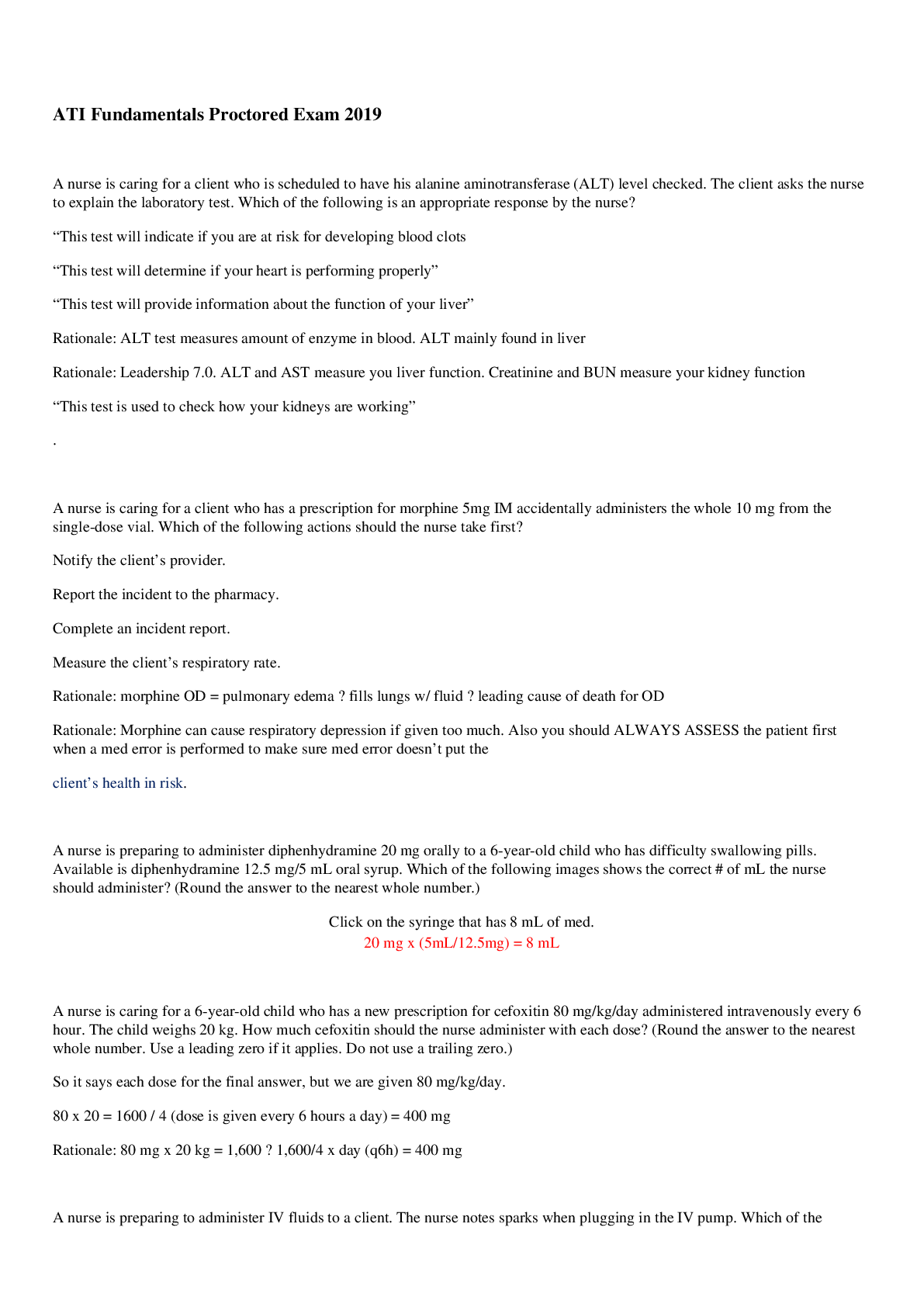


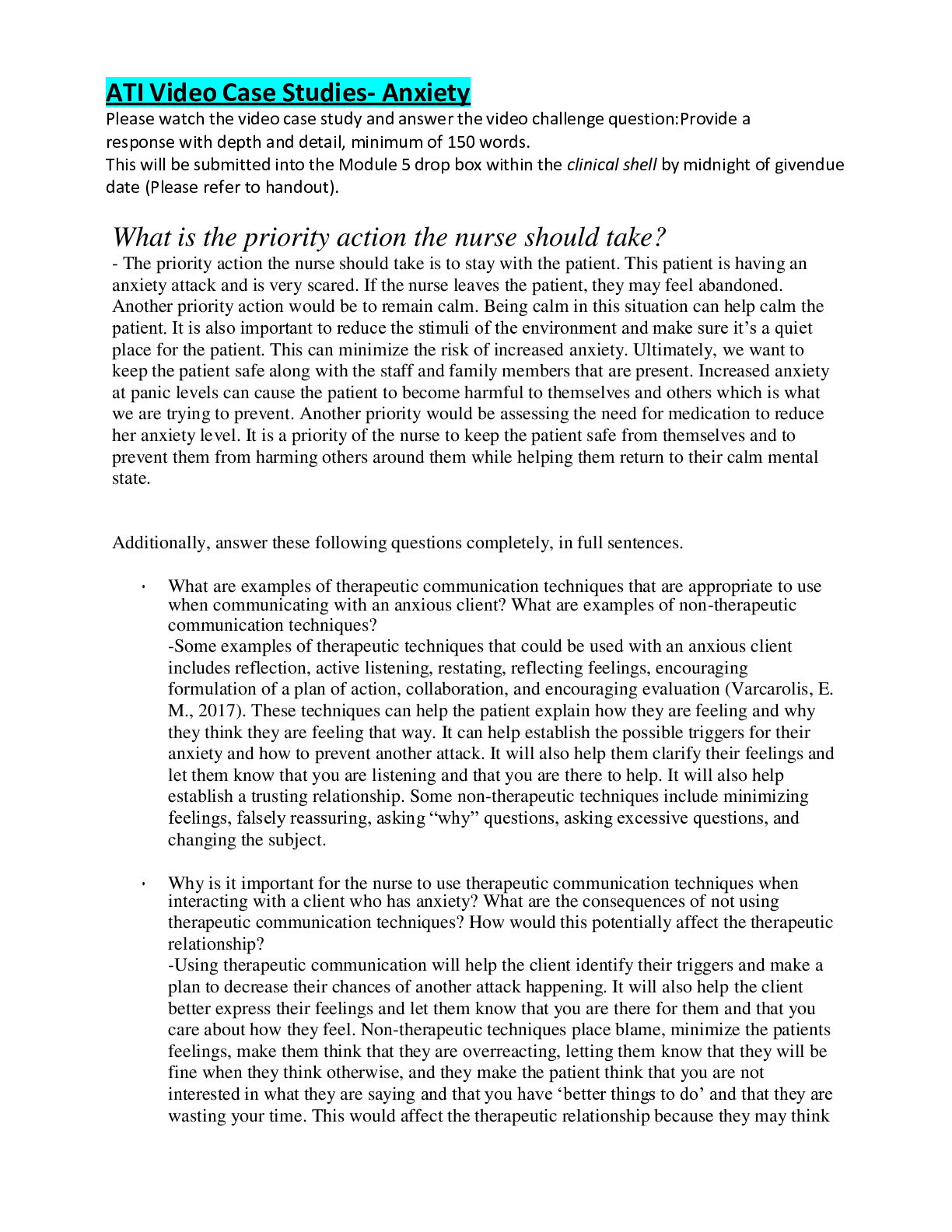
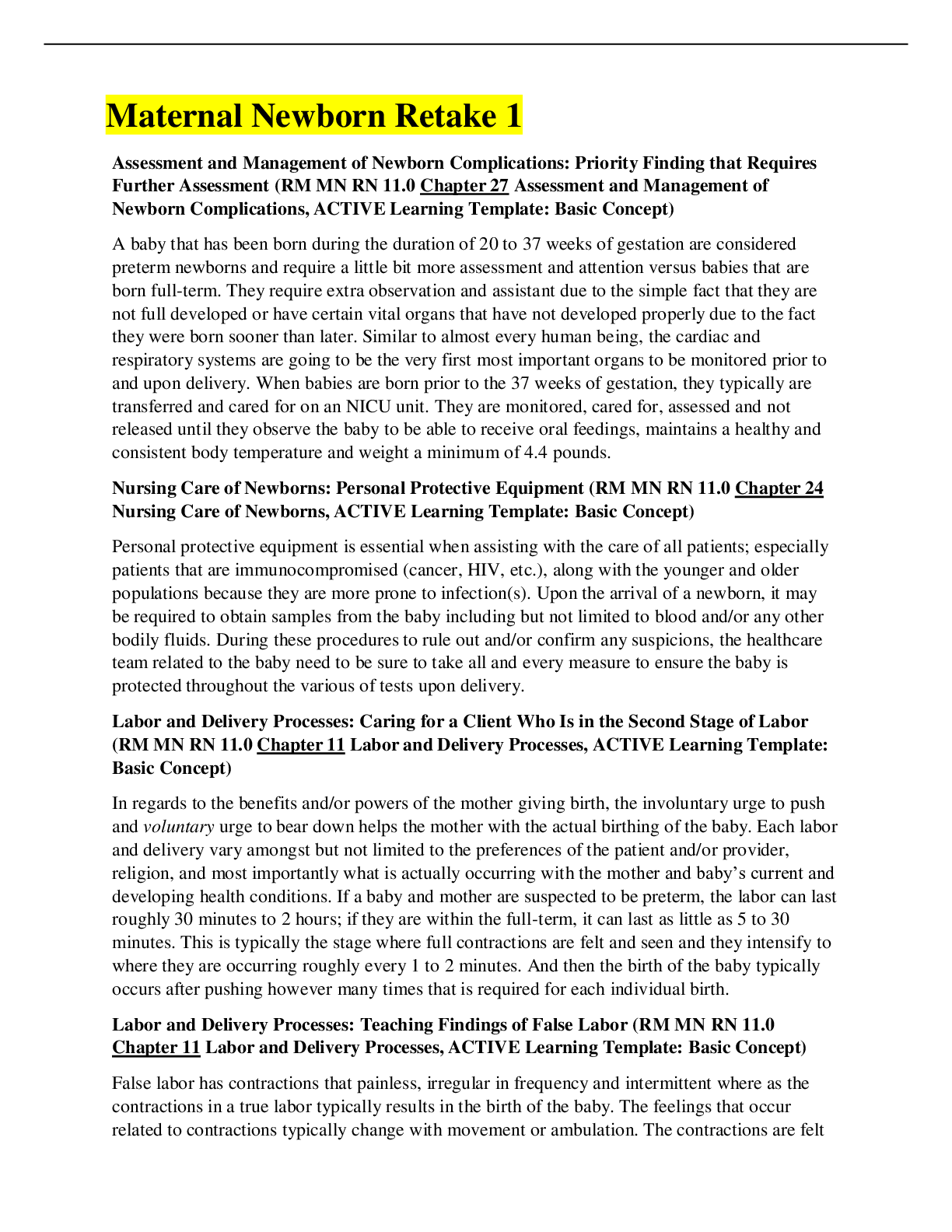
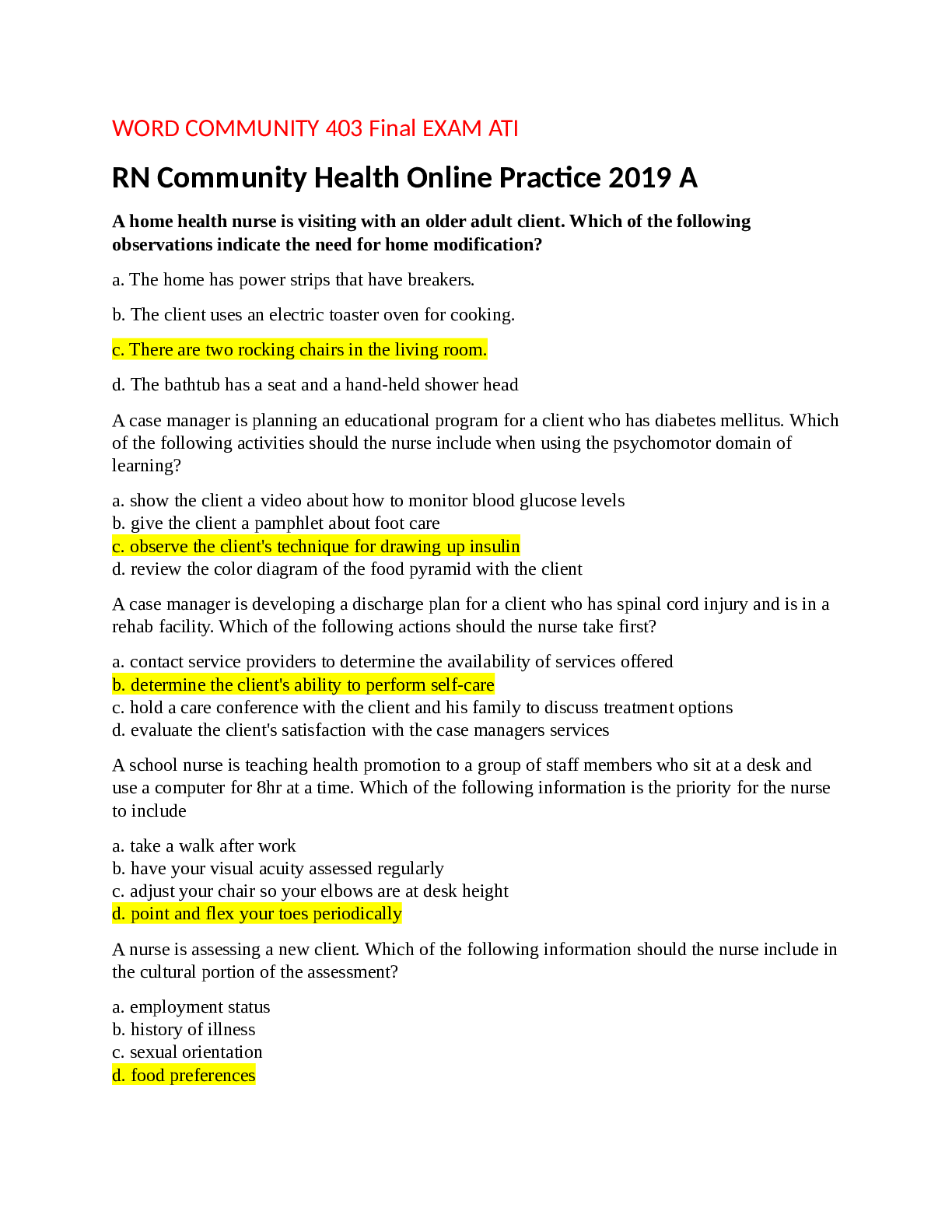

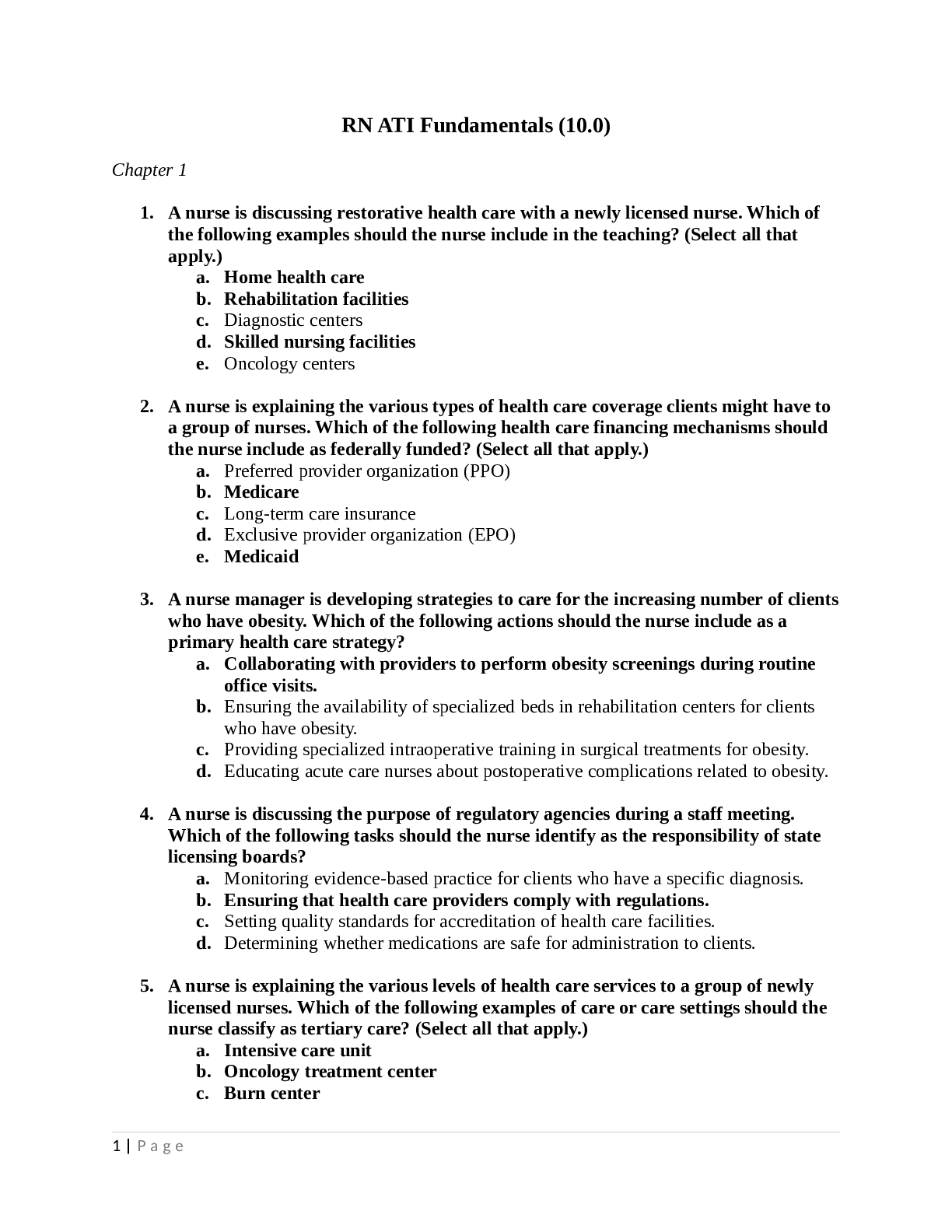
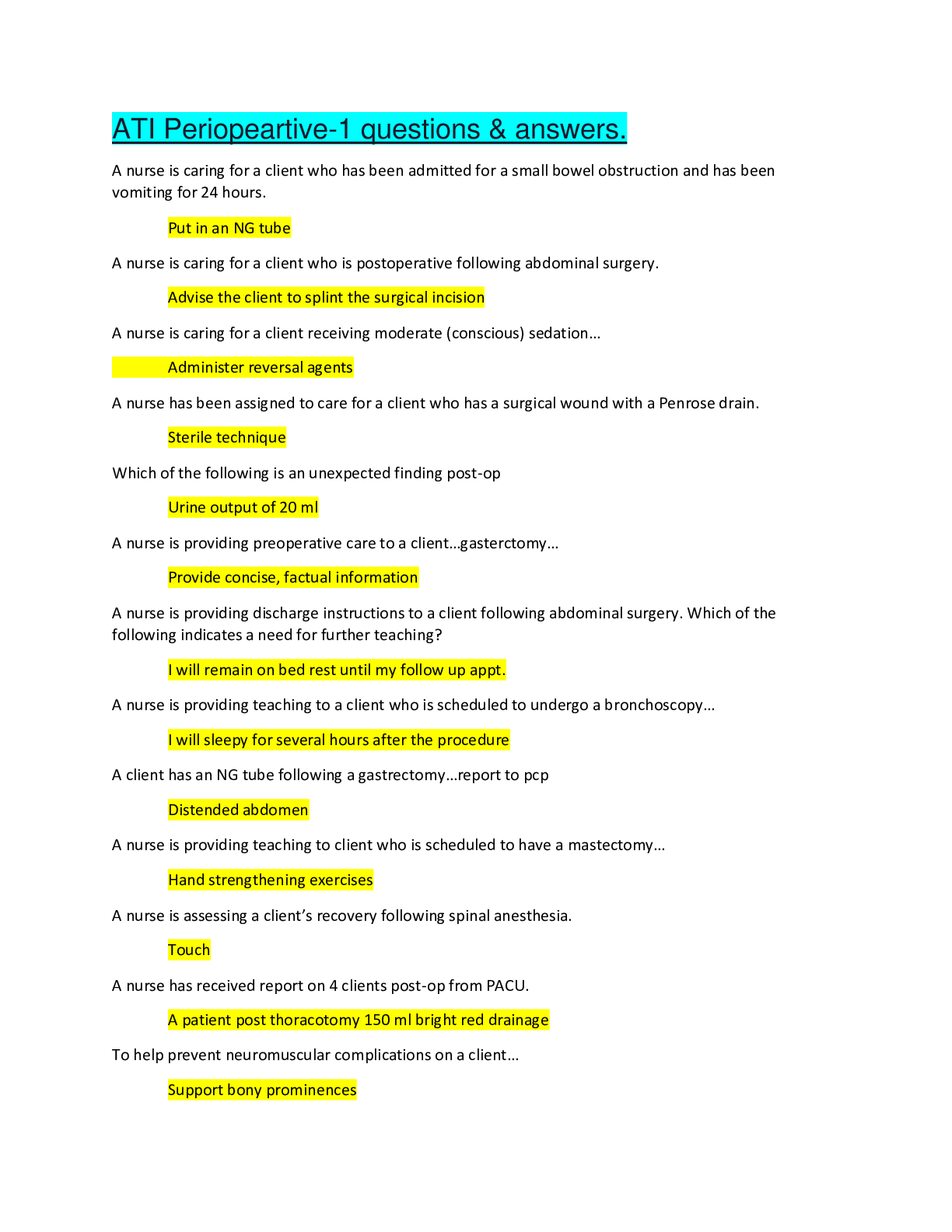
.png)
